In 1825, the McDonald brothers bought Sir John Johnson’s land to the east of the Gananoque River and therefore had ownership of the east bank grist and saw mills. That is the current orthodoxy, but the assessments tell a different story. C & J McDonald had been leasing the mills since 1818 and Johnson’s millers, Thomas and Samuel Howland, were gone from the mill assessments. The control of Johnson’s mills may have been ceded even earlier. The 1813 township census, alluded to previously, noted that Samuel Howland was “a servant of Col Stone”, even while Samuel Howland was being taxed for Johnson’s mills. A curious development.
“In 1815 Stone seems to have retired, leasing his land on the west side of the Gananoque River to McDonald. That year McDonald set up a shop apart from his house and also planned a new saw mill as a replacement for Stone’s old mill. In operation by 1816, the mill was later described by Robert Gourlay as ‘a very superior kind, supposed to be the best in two provinces.’ In 1817 McDonald acquired the area’s only grist mill, presumably from Thomas Howland or his brother.” [1]
That is shown in the 1818 assessment. After that, the Howlands’ names disappear from the mill assessments. In 1817, Charles’ brother John arrived in Gananoque, and they created C & J McDonald Company.
“Formed primarily as a lumbering business, the company would take advantage of the expanding market for colonial timber protected by British preferential tariffs.”[2]
C & J McDonald’s “. . . inventory of mercantile goods grew in both volume and variety while its inventory of lumber in Gananoque and Montreal doubled between 1819 and 1822. During this period, a second saw mill was acquired upriver on the Gananoque.”[3]
The McDonalds had acquired a share of John Howard’s saw mill at Marble Rock, which is why we see the McDonalds being assessed for 1¼ saw mills.
“In 1824 the McDonalds, together with Colonel Stone, had secured the Sir John Johnson grant.”[4]
We can see from the assessments that the McDonalds had been leasing Johnson’s mill since 1818. With that purchase, the McDonalds were free to develop the Gananoque area as they saw fit. But their focus was still mainly on the lumber and grist milling enterprises.
Thaddeus Leavitt (page 126) stated that:
“In 1826, the firm of C & J McDonald & Brother erected the largest flouring mill in the Province (now known as the Globe Works).”[5]
We can see in the assessment that in 1827, the McDonalds had expanded their operation significantly.
“With the extension of British tariff preferences to Canadian wheat and flour between 1825 and 1827, the McDonalds seized the opportunity to capitalize on the potential of the new trade. Heretofore lumbering had been the main thrust of the business, but by December 1825, a new grist mill was under construction. Plans were also under way for a new dam, an enlarged mill-race and a new wharf.”[6]
“Wheat for the mills was purchased locally and by agents throughout the region of the province around the upper St Lawrence. The brand of flour put out by C & J McDonald and Company became well known, as the ‘Gananoque Mills’ gained for the firm a prominent position in the flour and wheat trade in Canada.”[7]
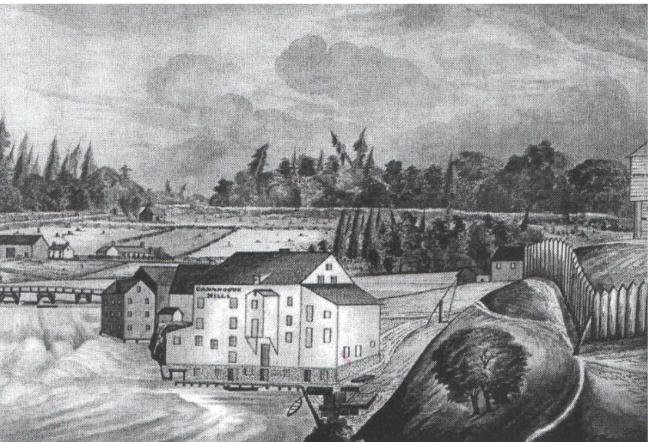
Freeman Britton, in his Souvenir of Gananoque, printed in 1901, added some more to the story.
“In 1826, the Messrs McDonald erected a large flour mill and warehouse on the east side of the river. This was, at the time, and for many years, the largest mill in Canada. It was owned by Mr WS McDonald, eldest son of Charles, after his father’s death, but was turned to other uses after 1852, when milling became unprofitable, and was burned in March 1881. When this mill was erected, a dam was built a short distance above the falls, and a canal was dug from above the new dam, parallel with the river, to the mill below the falls.”
This canal (locally called the raceway) is still in use today. It is here we learn that the current dam, in its first incarnation, was built in 1826. We also learn that after 1852, the Globe Works was leased out to some smaller businesses, such as Elijah Abbott’s machine works.
There was another first-hand account of the mill operations that filled out how the mills operated.
“When the Reverend William Bell visited the mills in August 1830, he reported that he ‘had never before seen an establishment so extensive, so ingenious, and so complete’ and he was told that the mills were capable of producing 160 barrels of flour a day. Although he found the saw mills no less impressive, and reported that ‘many hands were employed in the river, rafting timber and plank, for the Quebec market’, this side of the business appears to have been considered secondary to grist-milling. In 1831 the company sent to Montreal and Quebec 20,000 barrels of flour and 10,000 bushels of wheat, as well as lumber from 10,000 logs.”[8]
Charles McDonald died in 1826 shortly after constructing the Globe Works, but he and Mary had three boys. One, William Stone McDonald, had been groomed to carry on the business. Joel Stone died in 1833 at the age of 84, and everything devolved to the McDonalds. William Stone McDonald joined the firm in 1834 and with his uncle John, carried on the business until John withdrew in 1851 to live the life of a gentleman.
Gananoque remained mainly a milling and lumbering village for a couple more decades according to the assessment rolls, but that is only because other types of industries weren’t taxed, so they weren’t recorded. The first real look at how Gananoque was progressing is found in the 1842 Canada West census. It listed all businesses in the village. Although milling was still the dominant industry, there were some new businesses that also relied on water power. Listed in Gananoque were:
WS McDonald, merchant, with 2 grist mills, 8 grist operations running extra grinding stones, 1 thrashing mill, 1 potash and pearl ash manufactory, and a nail factory that produced 100 tons of nails.
Reuben Colton operated an iron works. J W Parmenter had a thrashing mill, and Alexander Auchinvole was operating a tannery.
The first Directory for the Province wasn’t published until 1846. Although it didn’t mention names, it did describe the industrial capacity of the village, which confirms the 1842 census. It does though, mention that the first woollen mill had started operations.
“It contains about 300 inhabitants, who have a church (Presbyterian). Post Office, post every day. Professions and trades: Grist mill (4 run of stones), saw mill, nail works, carding machine and cloth factory (see 1848), pail factory . . .”
The 1848 Johnstown District census is the next look we get at how the industrial growth was progressing. Although it provided more details about the output of the businesses, and although new industries were beginning to make a show, the picture still wasn’t that impressive.
WS McDonald: Grist mill, 8 employees; Grist mill, 2 employees, output 40,000 barrels of flour; Oat mill, output 250 cwt;[9] Saw mill, 4 employees, output 500,000 board feet; and Nail Factory, 3 employees, output 100 tons.
There were some other water mill related returns for Gananoque:
Alexander Auchinvole, Tanner produced 6610 lbs of hides; Robert Brough, Turning Factory, produced 12,360 units of handles for various tools. James Smith, Cloth Dresser, Woolen Factory, produced 5,000 yards of woolen cloth.
The time wasn’t ready yet for large industries in Gananoque or elsewhere in Upper Canada. The population still hadn’t grown to the size large industries were practical. The Canada Directory, 1851, states on page 572:
“Manufactures in Canada are as yet in their infancy. It is true, a considerable quantity of iron wares, axes, &c., are produced annually, and of excellent quality, coarse woollen goods, blankets and cottons are also manufactured to some extent, but the demand for labour in any of these departments is not such as to justify the expectation that any considerable number of additional hands would meet with ready employment.”[10]
By the time of the 1857-58 Lovell’s The Canada Directory, manufacturing that relied on water power was becoming more diverse. But even then, the manufacturers catered mainly to the rural trade.
DS Abbott, iron founder and machinist, Alexander Auchinvole, tanner; Robert Brough, turner and rake manufacturer; CW Ingram, manufacturer of harness mountings; DF Jones & Co, manufacturers of every description of shovels, spades, hoes, forks; William S MacDonald, proprietor of nail factory, saw, flouring and oat mills, and school trustee ; William Middleton, wheelwright and carriage maker George Mitchell, turner and carriage maker; William E Potter & Son, woollen factory S Skinner & Son, (late Skinner & McCullough, Brockville), manufacturer of harness and general saddlery, hardware, &c
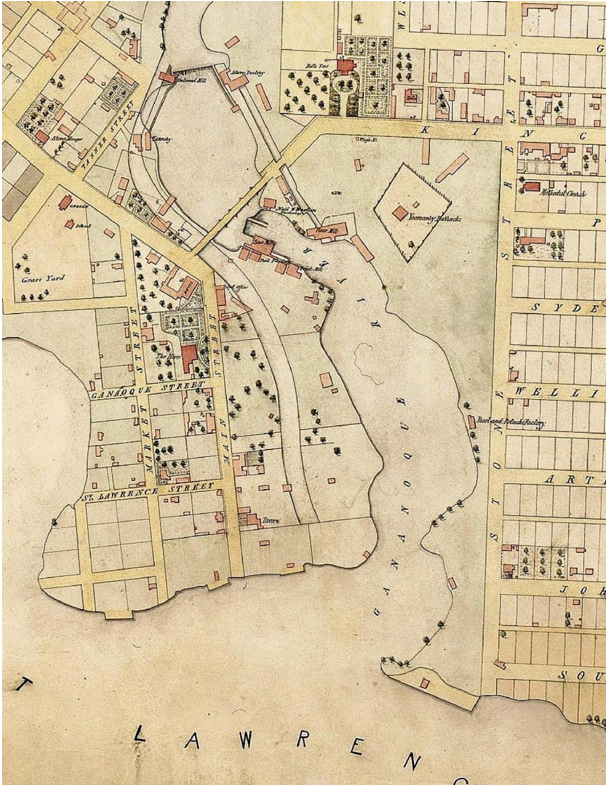
The 1861 census was timely as it coincided with the below map. Its commercial return gives us our best and most detailed look at the development of industry in Gananoque to date.
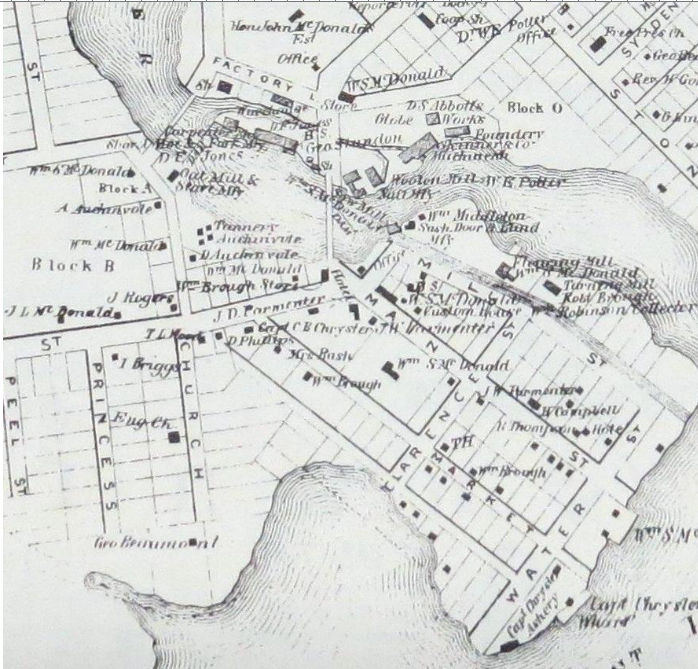
William Edwards, carpenter (no further return).
Edwards appears to have minimized his activities.
“The late Mr Edwards Sr [11]assured me that in that year [1859] he took down the remaining timbers of the blockhouse and used them in the construction of his workshop immediately below the site of the blockhouse on the river’s edge . . . It stood exactly where the brick building still stands on the spot for the sake of which the shop was taken down . . . the Skinner Co wished to erect a foundry for brass castings there . . .”
Edwards appears to have been a self-starter as he was only 24 in 1861. He went on to become a furniture maker and boat builder.
William Pierson, miller, heading and shingle machine
William Middleton, turning factory, 1 saw mill, 1 lath factory, 1 shingle machine, planning machines, tenoning and mortice machines, cap invested $1,000, input 500,000 bf lumber (val $4,000), water power, 10 men, $200/mo, output 600,000 laths ($900), 600,000 shingles ($1,200), building houses ($4,000)
Robert Brough, turning factory, cap $7,000, input 50,000 bf lumber (val $500), water power, 4 men, $96/mo, output 25,000 hay rakes ($2,000), 10,000 wheel heads ($2,000)
D Ford Jones, agricultural implements, cap $25,000, input 80 tons iron and steel (val $7,000), water power, 20 men, $600/mo, output shovels, spades, forks, hoes, cultivator tools (val $30,000)
Alexander Auchinvole, tanner and currier, cap $2,000, input 1800 hides (val $4,400), water power, 5 men, $100/mo, finished value $4,000
Silvester Skinner (Skinner & Co), hame factory, cap $1,600, input 50 logs ($75), 10 tons iron ($400), water power, 24 men, $350/mo, output 6,300 pair hames (val $3,780)
George Mitchell, carpenter, millwright, joiner, cap $583, water power, 4 men, $132/mo, equipment: 1 Planing machine, 1 mortice machine, 1 tenon machine, circular saw, shaping machine (tongue and grooving); input: 15,000 bf pine ($150), 10,000 bf hemlock ($80), 5,000 bf maple ($75), 5,000 bf oak ($75) and 6,000 bf basswood ($50). Output: 9 farm wagons ($310), 5 pleasure carriages ($280), 11 snow sleighs ($144), 1500 sashes ($75), 24 doors ($60), 2 buildings ($1,150)
George Brereton, woolen factory, cap $1,000, input: 3500 lbs wool ($870), water power, 2 men $32/mo, 4 women $24/mo. Output: 900 yds ‘satinet’ ($421), 2,000 yds full cloth ($1,200), 500 yds flannel ($200)
On the above map the woolen mill is still shown as WE Potter’s mill.
Isaac Briggs, carriage springs and nail works, cap $12,000, input 180 tons iron ($12,600), 12 tons zinc ($1,120), water power, 12 men, $360/mo, 185 tons nails ($21,000).
WS McDonald, 1 custom mill, 1 mill 4 run of stones, cap $50,000, input 100,000 bushels of grain ($75,000), water power, 5 men, $125/mo. Output: 27,000 100 lb bags flour ($60,000), 6,000 bags bran and shorts ($5,000), 25,000 bags feed ($15,000).
After 1861, the number of industries grew at a greater pace with industries that were more truly industrial in nature. The era of agricultural and lumber mills was being eclipsed. By 1868, the leading industrialists in the village formed the Gananoque Water Power Company to regulate the water supply. Factory owners bought shares in the company and that determined the amount of water to which each establishment was entitled. Why this company was formed when it was, is covered in my article “The Tumultuous Origins of the Gananoque Water Power Company” in the 8 August 2021 issue of TI Life. Another benefit of the company was that it took control of the water distribution away from the McDonald family, who had been capricious at times in the control of the water flow to various mills.
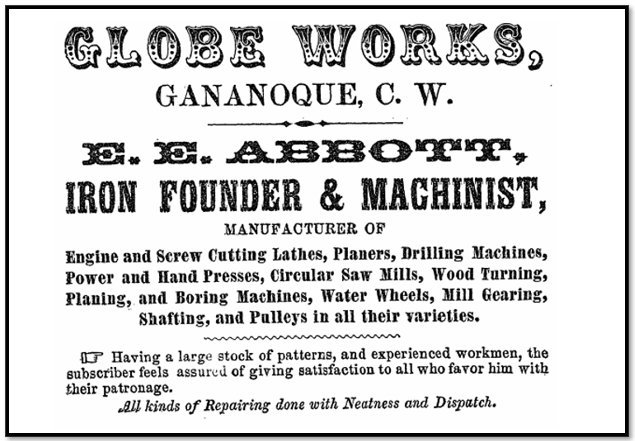
In 1879 Leavitt published his invaluable History of Leeds and Grenville. In it he discussed the industries he found in Gananoque at least until 1878 . This also serves as a substitute for a directory, as the surviving directories jump from 1871 to 1884.
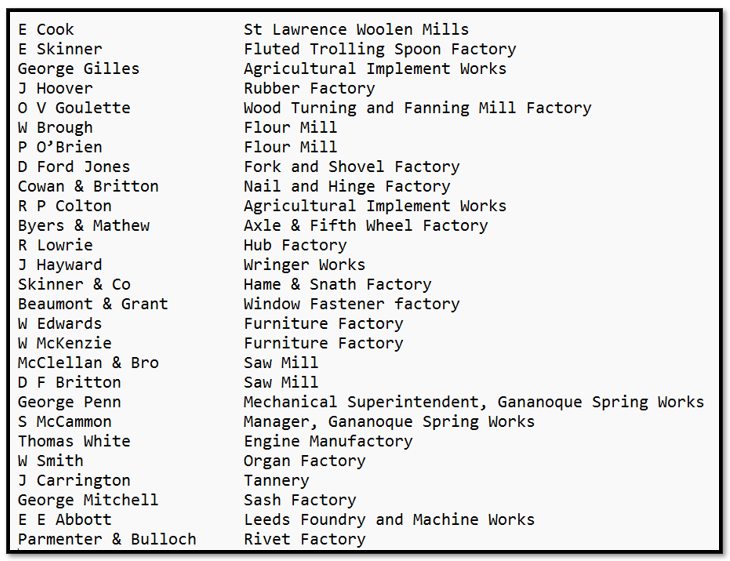
Due to its water power and the growth of the population, in the Province Gananoque was finally diversifying its industrial capacity. With that, we will leave the last words to Leavitt.
“Gananoque has with justice been called the Birmingham of Eastern Ontario, the Gananoque River furnishing an almost unlimited water power which has been utilized by the construction of a hydraulic canal, thus passing from one factory to another as motive power in setting in motion the wheels of industry. The village is charmingly situated upon the bank of the St Lawrence and contains a population of 3,000.”
Footnotes:
[1]http://www.biographi.ca/en/bio/mcdonald_charles_6E.html
[2]http://www.biographi.ca/en/bio/mcdonald_john_1787_1860_8E.html
[3]Ibid, Charles McDonald
[4] Thaddeus Leavitt, History of Leeds and Grenville, 1879, Recorder Press, Brockville; reprinted 1972, Mika Silk Screening Ltd, Belleville, ON, p 131
[5]It may be that the McDonalds wanted to give their operation a celebrated name. In 1825 a huge factory was built in Sheffield, England and it was called the Globe Works.
[6]Ibid, Charles McDonald
[7]Ibid, John McDonald
[8]Ibid, John McDonald. Bell was the Presbyterian minister in Perth.
[9]Under the American system a cwt (or hundred weight) = 100 lbs (or 25,000 lbs); under the British system it equaled 112 lbs (or 28,000 lbs). There is no indication which system was used.
[10]http://www.collectionscanada.gc.ca/obj/001075/f2/nlc003645.pdf
[11] Gananoque Blockhouse 1813-1859, Frank Eames, booklet privately published 1951, page 9
By Paul Coté
The Origins of Gananoque Part I by Paul Coté: January 2024
Paul Coté is a resident of Gananoque. He has socialized and worked on the River for most of his life. History has always been a passion and he is a self-confessed genealogy addict. Recently retired from contracting on the river, he now has time to pursue and write about his research. He is currently working on a book tentatively titled "The Shaping of Early Gananoque" and he has also published two more books: one titled "One Room Schools" in the Rear of Yonge and Escott Township and another one on "The Early Water Powered Mills and the Evolution of the Roads" concerning the same township. His book, "Sheatown: A Vanished Irish Catholic Community in Protestant Yonge Township, Leeds County" was reviewed in TI Life December 2019 issue.
Editor's note: This is the 2nd part of a review of the town of Gananoque, ON. As this editor is infatuated by history - and as I have written about the history of Gananoque in the past, I truly appreciate Paul Cote's studies - this is like finding gold!
Posted in: Volume 19, Issue 1, January 2024, History, People, Places
Please click here if you are unable to post your comment.
